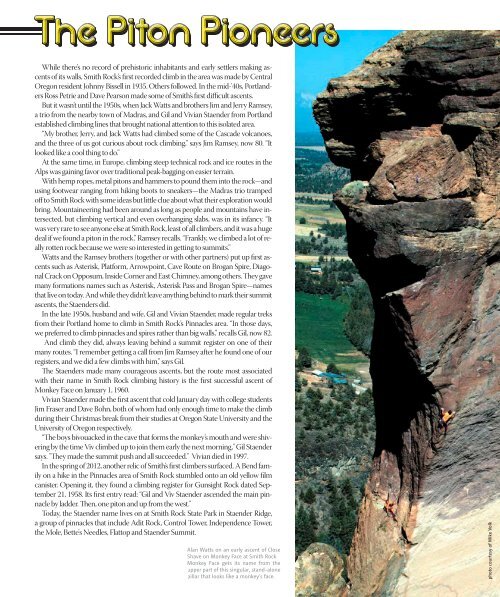You also want an ePaper? Increase the reach of your titles
YUMPU automatically turns print PDFs into web optimized ePapers that Google loves.
The Piton Pioneers<br />
While there’s no record of prehistoric inhabitants and early settlers making ascents<br />
of its walls, Smith Rock’s first recorded climb in the area was made by Central<br />
Oregon resident Johnny Bissell in 1935. Others followed. In the mid-'40s, Portlanders<br />
Ross Petrie and Dave Pearson made some of Smith’s first difficult ascents.<br />
But it wasn’t until the 1950s, when Jack Watts and brothers Jim and Jerry Ramsey,<br />
a trio from the nearby town of Madras, and Gil and Vivian Staender from Portland<br />
established climbing lines that brought national attention to this isolated area.<br />
“My brother, Jerry, and Jack Watts had climbed some of the Cascade volcanoes,<br />
and the three of us got curious about rock climbing,” says Jim Ramsey, now 80. “It<br />
looked like a cool thing to do.”<br />
At the same time, in Europe, climbing steep technical rock and ice routes in the<br />
Alps was gaining favor over traditional peak-bagging on easier terrain.<br />
With hemp ropes, metal pitons and hammers to pound them into the rock—and<br />
using footwear ranging from hiking boots to sneakers—the Madras trio tramped<br />
off to Smith Rock with some ideas but little clue about what their exploration would<br />
bring. Mountaineering had been around as long as people and mountains have intersected,<br />
but climbing vertical and even overhanging slabs, was in its infancy. “It<br />
was very rare to see anyone else at Smith Rock, least of all climbers, and it was a huge<br />
deal if we found a piton in the rock,” Ramsey recalls. “Frankly, we climbed a lot of really<br />
rotten rock because we were so interested in getting to summits.”<br />
Watts and the Ramsey brothers (together or with other partners) put up first ascents<br />
such as Asterisk, Platform, Arrowpoint, Cave Route on Brogan Spire, Diagonal<br />
Crack on Opposum, Inside Corner and East Chimney, among others. They gave<br />
many formations names such as Asterisk, Asterisk Pass and Brogan Spire—names<br />
that live on today. And while they didn’t leave anything behind to mark their summit<br />
ascents, the Staenders did.<br />
In the late 1950s, husband and wife, Gil and Vivian Staender, made regular treks<br />
from their Portland home to climb in Smith Rock’s Pinnacles area. “In those days,<br />
we preferred to climb pinnacles and spires rather than big walls,” recalls Gil, now 82.<br />
And climb they did, always leaving behind a summit register on one of their<br />
many routes. “I remember getting a call from Jim Ramsey after he found one of our<br />
registers, and we did a few climbs with him,” says Gil.<br />
The Staenders made many courageous ascents, but the route most associated<br />
with their name in Smith Rock climbing history is the first successful ascent of<br />
Monkey Face on January 1, 1960.<br />
Vivian Staender made the first ascent that cold January day with college students<br />
Jim Fraser and Dave Bohn, both of whom had only enough time to make the climb<br />
during their Christmas break from their studies at Oregon State University and the<br />
University of Oregon respectively.<br />
“The boys bivouacked in the cave that forms the monkey’s mouth and were shivering<br />
by the time Viv climbed up to join them early the next morning," Gil Staender<br />
says. "They made the summit push and all succeeded." Vivian died in 1997.<br />
In the spring of <strong>2012</strong>, another relic of Smith’s first climbers surfaced. A Bend family<br />
on a hike in the Pinnacles area of Smith Rock stumbled onto an old yellow film<br />
canister. Opening it, they found a climbing register for Gunsight Rock dated <strong>Sept</strong>ember<br />
21, 1958. Its first entry read: “Gil and Viv Staender ascended the main pinnacle<br />
by ladder. Then, one piton and up from the west.”<br />
Today, the Staender name lives on at Smith Rock State Park in Staender Ridge,<br />
a group of pinnacles that include Adit Rock, Control Tower, Independence Tower,<br />
the Mole, Bette's Needles, Flattop and Staender Summit.<br />
Alan Watts on an early ascent of Close<br />
Shave on Monkey Face at Smith Rock.<br />
Monkey Face gets its name from the<br />
upper part of this singular, stand-alone<br />
pillar that looks like a monkeys face.<br />
photo courtesy of Mike Volk

















